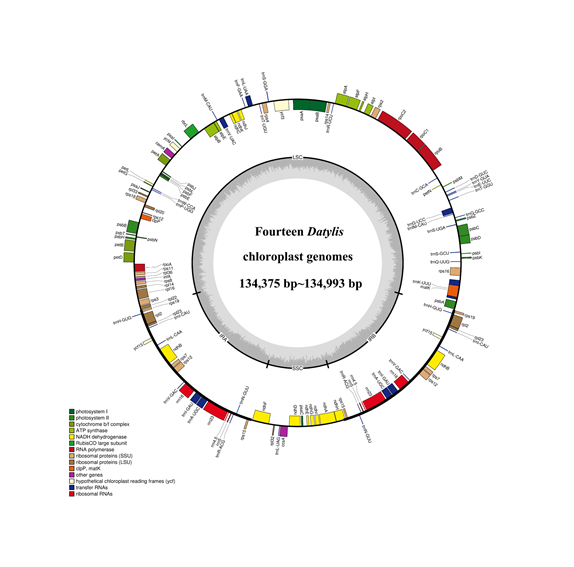Complete Chloroplast Genomes of 14 Subspecies of D. glomerata: Phylogenetic and Comparative Genomic Analyses
2022年09月14日 10:55
Complete Chloroplast Genomes of 14 Subspecies ofD. glomerata: Phylogenetic and Comparative Genomic Analyses
Yongjuan Jiao†, Guangyan Feng†, Linkai Huang, Gang Nie, Zhou Li, Yan Peng, Dandan Li, Yanli Xiong,
Zhangyi Hu and Xinquan Zhang*
*Correspondence: zhangxq@sicau.edu.cn.
†These authors contributed equally to this work.
DOI:https://doi.org/10.3390/genes13091621
发表期刊:genes
链接:https://www.mdpi.com/2073-4425/13/9/1621
Abstract: Orchardgrass (Dactylis glomerataL) is a species in theGramineae family that is highly important economically and valued for its role in ecology. However, the phylogeny and taxonomy ofD. glomerataare still controversial based on current morphological and molecular evidence. The study ofchloroplast (cp) genomes has developed into a powerful tool to develop molecular markers for related species and reveal the relationships between plant evolution and phylogenetics. In this study, we conducted comparative genomic analyses and phylogenetic inferences on 14 cp genomes ofD. glomerataoriginating from the Mediterranean and Eurasia. The genome size ranged from 134,375 bp to 134,993 bp and exhibited synteny of gene organization and order. A total of 129–131 genes were identified, including 85–87 protein coding genes, 38 tRNA genes and 8 rRNA genes. The cp sequences were highly conserved, and key sequence variations were detected at the junctions of inverted repeats (IRs)/small single–copy (SSC) regions. Moreover, nine highly variable regions were identified among the subspecies based on a sequence divergence analysis. A total of 285 RNA editing sites were detected that were relevant to 52 genes, whererpoBexhibited the most abundant RNA editing sites.The phylogenetic analysis revealed that allDactylissubspecies clustered into a monophyletic group and most branches provided a high support bootstrap. The main divergence time ofD. glomeratawas dated to the Miocene era, and this could have been due to changes in the climate. These findings will provide useful insights for further studies on phylogeny, the identification of subspecies and the development of hypotheses for the evolutionary history of the genusDactylisandof the Gramineae family.

Figure 1.Representative cp genome ofDactylissubspecies.Genes drawn inside and outside of the circle are transcribed in clockwise and counter–clockwise directions, respectively. The colored bar indicates chloroplast gene groups. The dark gray bar graphs inner circle shows the GC content, and the light gray bar graphs show the AT content.